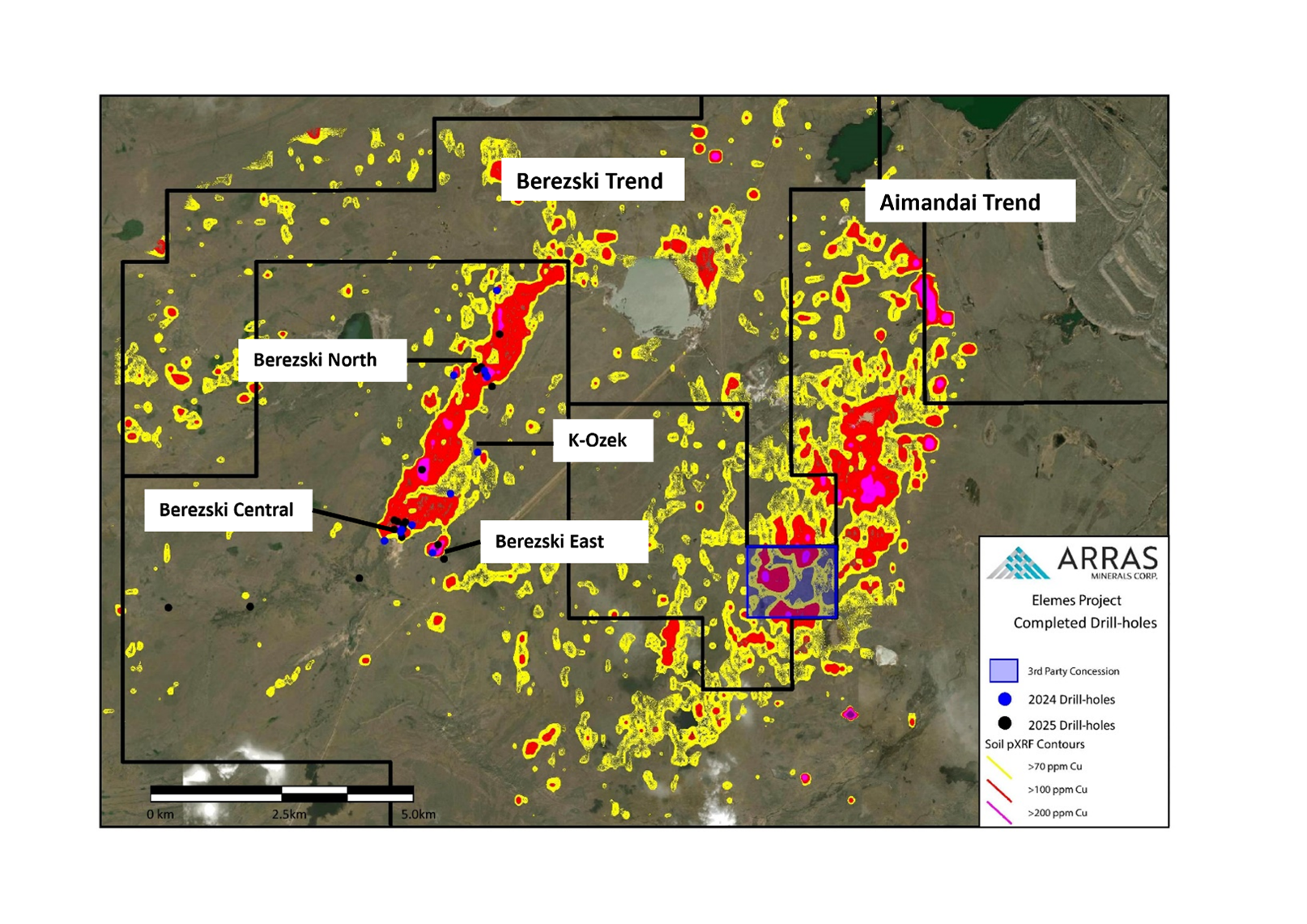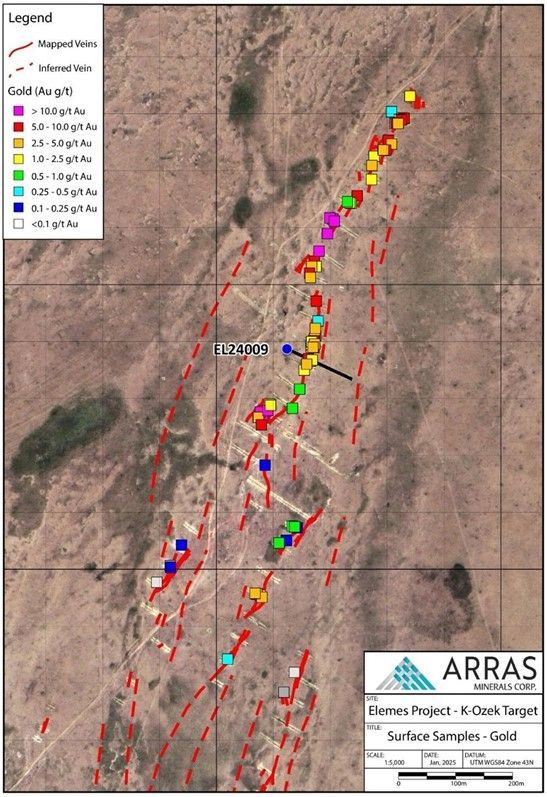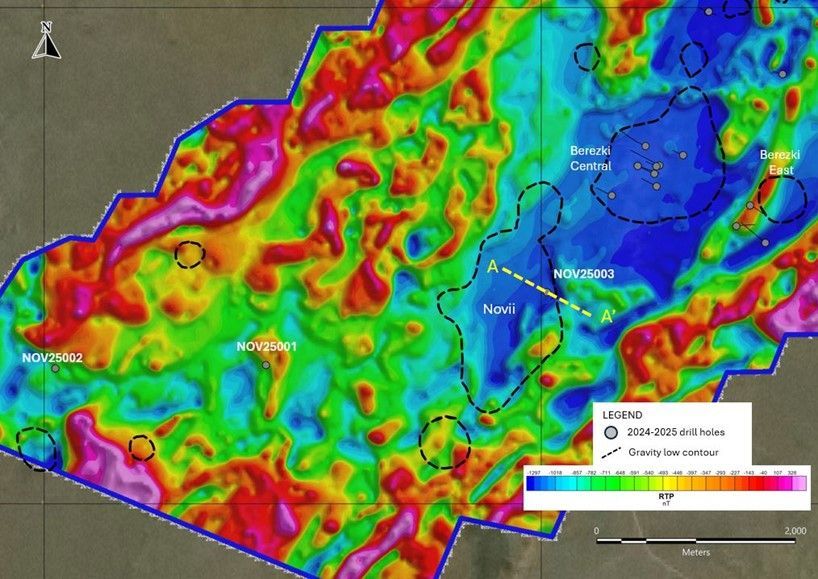ELEMES
Elemes Project (Elemes and Aimandai Licenses)
OVERVIEW
The Elemes project consists of two exploration licenses covering 531.2 square kilometers and is located 23km to the southwest of the town of Ekibastuz in Pavlodar region of Kazakhstan. Copper mineralization was discovered by the Soviets during regional exploration programs conducted in the 1950s, that identified a large Cu-Mo geochemical target.
GEOLOGY
The property geology is dominated by interbedded intermediate volcanic and sedimentary rocks, into which a series of intrusive rocks have been emplaced. Copper-gold mineralization consists of sheeted and/or stockwork quartz-chalcopyrite veins associated with Diorite and Monzodiorite porphyry intrusions and mapping has also identified several high-grade low-sulphidation epithermal veins and represent a second exploration target at Elemes. The license package has limited geological outcrop with much of the geology under 10 – 40 meters of unconsolidated cover.
GEOCHEMISTRY
A property-wide soil sampling program conducted by Arras from 2022 to 2024, totaling more than 35,000 samples defined two large Cu-Mo-As geochemical trends called Berezski and Aimandai. A Phase 1 core drill program commenced in Q4 2024 with results announced in Q1 2025. A 20,000-meter, Phase 2 core drill program commenced in May 2025 which will continue into 2026.
GEOPHYSICS
In 2022, the company completed a property wide airborne magnetic survey that defined a 6.5km long magnetic low centered on the Berezski Trend. This work was followed up in 2024 by a high-resolution, 674-line kilometer ground magnetic survey, to help the company define the structural controls and alteration associated with porphyry systems.
In 2024, 125-line kilometer long Pole-Dipole Induced Polarization study was completed over the Berezski Trend, with a line spacing of 5km. The objective of this program was to map out chargeability anomalies caused by sulphide mineral distributions associated with porphyry and epithermal mineralization, and in 2025 a 64.9 square kilometer Vector-array Inducted Polarization and a 24.6 line-kilometer Pole-Dipole Induced Polarization surveys were completed over the Aimandai Trend in 2025.
This work was followed up with a 75 sq km Magnetotellurics (MT and Gravity surveys over the high-priority areas of the Berezski and Aimandai trends. The results from these surveys are expected in early 2026.

EXPLORATION TARGETS (Berezski Trend)
Geophysics, soil sampling and core drilling combined have identified high-priority targets through the 2024 – 2025 exploration programs. General summaries are provided below:
Berezski Central
Berezski Central is mapped as a 1.5 x 0.5 km area of outcropping Argillic alteration with local remnants of quartz-hematite (after pyrite) veins and veinlets. Rocks are saturated with pervasive iron oxides and hematite dissemination suggesting a pyrite rich system. Argillic alteration is a mixture of kaolinite-illite with low presence of Quartz. The oxidation zone is strongly developed on the surface leaving usually saprolite as a final product but with recognizable textures of intrusive rock.
Drilling completed by Arras in 2024 and 2025 has intersected thick intervals of porphyry-style copper-gold mineralization hosted in diorites starting from the surface. Mineralization consists of quartz - pyrite ± chalcopyrite veins and disseminated pyrite. Minor chalcocite (evidence for supergene enrichment) is observed in the upper portion of the drill-holes.
Berezski East
The mineralization at Berezski East is interpreted as a gold-rich copper-gold porphyry deposit, part of a much larger porphyry-epithermal system. Drilling by Arras confirmed high-grade, near-surface gold mineralization, predominantly represented by veins of quartz and quartz-pyrite, with occasional chalcopyrite. Magnetite and quartz-magnetite veins and veinlets prevail throughout almost the entire drill hole.
Drillhole EL25019 delivered an exceptional high-grade gold-copper intercept from surface at Berezski East. The hole intersected broad zones of potassic alteration and the presence of copper minerals such as bornite and chalcopyrite suggests this target, originally thought to be related to an epithermal system, may form part of a larger porphyry system. The KGK drilling (Q4 2025) appears to have expanded the footprint of the Berezski East mineralization to at least a 1000m strike length.
Berezski North
Historic shallow drilling at Berezski North focused on areas of structurally controlled hydrothermal breccias, that have been overprinted by later low temperature epithermal quartz veins. Drilling by the company in late 2024 discovered that these breccias represent the lower temperature top to a porphyry copper system. Drilling in 2025 continues to demonstrate the presence of a large porphyry system at Berezski North. Drilling has defined a 600 metre NW-SE trending zone at Berezski North that remains open in the northwest and southeast directions and at depth. Hole EL25016, approximately 300m southeast of Hole EL24005 intersected thick zones of high-grade copper-gold mineralization from surface, and hole EL25027 intersected thick zones porphyry-style mineralization indicating that the drilling is expanding the footprint of the porphyry system in this target area.
The Company also discovered a second area of porphyry-style mineralization, approximately 1km to the west of EL24005, where drill hole EL24006 intersected propylitic altered diorites that have been partially overprinted by argillic alteration, with quartz-pyrite-chalcopyrite porphyry-style veins and disseminated pyrite and chalcopyrite mineralization.
K-Ozek
The gold-silver mineralization is hosted in a zone of quartz veining (individual veins between 0.5 to 1 m width), that display typical low sulphidation textures including crustiform banding, euhedral crystal infill of vein voids, and bladed textures (quartz after calcite) (Figure 2 below). A zone of strong silicification and argillic (kaolinite-illite-quartz) alteration surrounds the quartz veins.
Sampling of the veins by Arras minerals (news release here) returned grades up to 29 g/t Au, 287 g/t Ag and 238 ppm Te, and a single hole drilled in 2024, returned several narrow zones of veining and silicification and disseminated pyrite, hosted in phyllic/argillic altered andesites and diorites.

Plan map of the K-Ozek target showing location of drill-hole EL24009, mapped veins and grab sample locations.
Novii
In late 2025, three holes, were drilled on the Novii Target. Holes NOV25001 and NOV25002 intersected interbedded volcaniclastics and sediments with zones of pyrite mineralization. However, drill-hole NOV25003, testing a major magnetic low and the margins of a large gravity low, a similar setting hosting mineralization at the Berezski Central and Berezski East targets, and intersected wide zones low low-grade porphyry-style mineralization, suggesting it intersected the edge of a new porphyry center, located 1.6km to the southwest of the Berezski Central Target. The new data from NOV25003 supports the theory that the Berezski Trend is much larger than originally thought. Further drill testing of the Novii target is planned.

Elemes ground magnetic survey and gravity low contour with location of drill holes NOV25001, NOV25002, NOV25003

